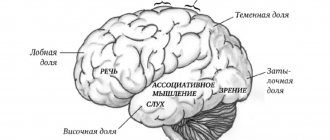Perception is a cognitive function of the psyche that forms an individual perception of the world. This function is a reflection of a phenomenon or object as a whole with its direct influence on the receptor surface parts of the sense organs. One of the core biological processes of the psyche, which determines the complex operation of receiving and transforming information acquired through the senses, which form a personalized holistic image of an object that influences analyzers through a complex of sensations caused by this object, is considered the function of perception or perception.
Perception in psychology is the process of direct active reflection by the cognitive sphere of the subject of internal objects and external objects or phenomena. As a form of sensory representation of an object, perception combines the identification of an object as inseparable, the distinction of individual qualities in it, the detection of informative content in it corresponding to the purpose of the action, and the development of a sensory image. Perception is the process of becoming aware of the stimulation of sensory receptors.
Social perception
The origin and further successful development of interpersonal communicative interaction is possible only on the condition that there is mutual understanding between the parties involved in this process. The extent to which subjects reflect each other’s feelings and qualities, understand and perceive others, and with their help, their own personality, largely determines the communication process, the relationships formed between the participants, and the methods by which they implement joint activities. Therefore, the process of cognition and comprehension by one subject of another acts as a mandatory component of communication. This component can roughly be called the perceptual aspect of communication.
Social perception is one of the most serious and most important phenomena of social psychology. The definition of social perception was first introduced by D. Bruner after the formation of a qualitatively different view of the subject’s perception of the subject.
Perception in psychology is an action that arises during the interaction of individuals with each other and combines the perception, passage, understanding and evaluation of social objects by individuals.
The concept of perception combines:
- individual process of perception of observed actions;
- interpretation of perceived causes of actions and expected consequences;
- building a personal behavior strategy;
- emotional assessment.
Social perception is the process of perceiving social objects in the social sense. This is a process that arises from personal interaction, is based on natural communications and occurs in the form of perception and comprehension of an individual by an individual.
Interpersonal perception is characterized by dependence on emotional reactions, views, attitudes, ideas, hobbies and prejudices. The nature of interpersonal relationships differs significantly from the essence of social relationships. Since a specific feature of interpersonal interaction is the presence of an emotional basis. Therefore, interaction of an interpersonal nature should be considered as the cause of the psychological “microclimate” of the team. The emotional foundation of interpersonal relationships combines all types of emotional reactions of the individual, such as feelings, affects, emotions.
There are certain mechanisms of social perception. First of all, these include identification, attraction and empathy.
The processes of social perception have a significant difference in the perception of objects of a non-social nature. This difference is that objects of a social nature do not have passive and indifferent traits in relation to the person of perception. In addition, social models are always characterized by the presence of evaluative interpretations and semantic judgments. In a sense, perception is interpretation. However, the interpretation of another person or group of persons always depends on the past social experience of the perceiving subject, the behavioral reactions of the object of perception at a particular moment, the system of value guidelines of the perceiving person and other factors.
There are fundamental functions of perception, which include: knowing oneself, a communication partner, organizing collective activities based on mutual understanding and establishing the necessary emotional relationship.
The functions of perception are necessary for a better understanding of the essence of perception. In the course of communicative actions, mutual understanding is necessary in order to effectively assimilate information. The perception of a communication participant is called the perceptual side of communicative interaction. This process can be represented as the internal foundation of the communication process, which has reached a fairly high level of development.
The phenomenon of social perception is based on the mutual understanding of subjects. Therefore, it should be noted that there are several levels of mutual understanding. The first level occurs when the system of social meanings and individual meanings of communicating individuals coincide, and there are no coincidences in the degree of mutual assessment of personal qualities.
An example of this level of perception is professional communicative interaction. The next level is observed when not only semantic systems coincide, but also the degree of mutual assessment of personal qualities. It is observed when subjects are mutually satisfied with their own emotions, which arise in relation to one person to another. The third level is when there is a high degree of mutually directed trust of individuals and their openness. Communication at this level presupposes the absence of secrets from each other, which significantly affect the interests of the partner.
Like any other mental process, perception is characterized by its properties.
Properties of perception include objectivity (the perception of objects not as an incoherent set of sensations, but as images that make up certain objects), structure (the object is perceived by consciousness as a simulated structure, abstracted from sensations), apperceptivity (the content of the psyche is affected), constancy (the immutability of perception object when the stimulus changes), meaningfulness (the object is perceived through consciousness, then mentally named and belongs to the class) and selectivity (singling out some objects over others). The properties of perception develop depending on the age period of the individual.
Halo effect
This is the tendency of the perceiver to exaggerate the homogeneity of the partner's personality, for example, to transfer a favorable impression of one quality of a person to all his other qualities.
There are several typical schemes for triggering the halo effect. Most often, a perception scheme is used, which is triggered in the event of inequality between partners in one area or another - social, intellectual, etc. This scheme begins to work not with every, but only with really important, significant inequality for the perceiver.
People tend to systematically overestimate the various psychological qualities of those who are superior to them in some important parameter for them. So, if I am sick and weak, but I want to be healthy and strong and I meet a person bursting with health and strength, then it is possible that I will overestimate him in all respects - in my eyes he will be handsome, smart, and kind.
In one ingenious experiment, students in different groups were shown the same man. In one group he was presented as a student, in the second as a laboratory assistant, in the third as a teacher, in the fourth as an assistant professor, in the last as a professor. After the guest left, the experiment participants were asked to determine as accurately as possible his height and the height of the experimenter himself. It turned out that the latter’s height did not change, but the height of the presented man steadily increased as his social status increased.
It can be assumed that the perception scheme in this case is as follows. When meeting a person who is superior to us in some important parameter; we evaluate him somewhat more positively than we would if he were our equal. If we are dealing with a person whom we are superior in some way, then we underestimate him. It is important that superiority is recorded in one parameter, while overestimation (or underestimation) occurs in many parameters. This perceptual error came to be called the effect of the superiority factor.
ALSO SEE: Feedback in Speaking and Listening
Another mistake associated with the halo effect is that if we like a person externally, then at the same time we tend to consider him better, smarter, more interesting, etc., that is, to overestimate many of his psychological characteristics.
Another scheme for triggering the halo effect is associated with the action of the “attitude towards us” factor: those people who love us or treat us well seem to us to be much better (smarter, fairer, etc.) than those who treat us poorly.
Thus, when forming a first impression, the “halo effect” manifests itself in the fact that a general positive impression of a person leads to an overestimation, and a negative impression leads to an underestimation of an unknown person. If at least one of the factors considered is at work in a communication situation—superiority, attractiveness, or attitude toward us—then the person will most likely apply one of the perception schemes and may make a mistake in assessing the partner.
Mechanisms of social perception
An individual always enters into communicative interaction as a person, and in the same way he is perceived by his fellow communicator as a person.
Communication as perception presupposes the presence of interpersonal perception - the development of an initial impression and interpersonal perception in general. Therefore, it is possible to identify mechanisms of social perception, which are specific ways that determine an individual’s interpretation, understanding and evaluation of a partner in communicative interaction. The most common mechanisms include causal attribution, identification, empathy, attraction, and social reflection. Below is a more detailed description of these mechanisms.
Causal attribution is the attribution of reasons for a behavioral response to a subject. Each individual unintentionally makes his own assumptions about the reasons for the actions of the perceived individual, why exactly he behaves in this way. Attributing various reasons for behavior to a partner, the observer does this based on the similarity of his behavioral reactions with either a person known to him or a known personality image, or based on an analysis of his own motives that could manifest itself in an individual in a similar situation.
Casual attribution operates on the principle of analogy and depends on some aspects of the self-perception of the individual who perceives and evaluates another.
A way of comprehending another, in which a hypothesis about his state of mind is built based on attempts to put himself in the place of a fellow communicator, is called identification. In other words, there is a comparison of oneself with a second individual. During identification, the partner’s norms, his values, behavioral reactions, habits and tastes are learned. Identification has a special personally significant meaning at a specific age stage, approximately during the transition period and adolescence. Since at this stage, identification largely determines the nature of the relationship between the young person and his significant environment.
Communication as perception consists in the understanding of each other by communicating persons and is mediated not only solely by the presence of a common system for encoding or decoding information and jointly directed action, but also by the specific features of the individual’s perception of the individual.
Empathy is emotional empathy with another individual. Through emotional responses, the individual comprehends the internal state of the partner. Empathy is based on the ability to correctly imagine and understand what is happening inside another individual, how he evaluates the environment, and what he is experiencing. Empathy in interaction with the second participant in communication is often considered as one of the most necessary professional traits of a psychologist, social worker and teacher.
Attraction is translated as attraction, and can be expressed as a special form of comprehension of another subject, based on the development of a stable positive feeling in relation to him. In this case, understanding of the interaction partner arises as a result of the formation of attachment, friendship or a deeper relationship of an intimate-personal nature towards him.
Through perception and subsequent interpretation of the environment and social environment, the subject also perceives and then interprets his own personality, actions and motives.
Social reflection refers to the process and consequence of an individual’s self-perception in a social context. By social reflection as a tool of social perception we mean a person’s understanding of his own individual characteristics and how they are expressed in external response, as well as comprehension of how he is perceived by the environment.
Interpersonal perception is typically governed by all of the above mechanisms.
Social-perceptual side of communication. Mechanisms and effects of interpersonal perception
In the process of communication there must be mutual understanding between the participants in this process. Mutual understanding itself can take two forms: 1) understanding of the motives, goals, and attitudes of interaction partners; 2) not only understanding, but also acceptance, sharing of these goals, motives, attitudes. In the second case, understanding allows not only to coordinate actions, but also to establish a special kind of relationship (closeness, affection), expressed in feelings of friendship, sympathy, love. In the course of knowing another person, several processes are simultaneously carried out: an emotional assessment of the other, an attempt to understand the motives of his actions, based on this strategy.
the strategy of changing his behavior, building a strategy for his own behavior, etc. However, at least two people are included in these processes and each of them is an active subject. Consequently, comparison of oneself with another is carried out, as it were, from two sides: each of the partners likens itself to the other. This means that when building an interaction strategy, everyone has to take into account not only the needs, motives, and attitudes of the other, but also how this other understands the needs, motives, and attitudes of his interlocutor. In other words, the perception of a person by a person involves special processes: identification and reflection. The term “identification” literally means becoming like another. This is one of the easiest ways to understand another person. In real interaction situations, people use this technique when an assumption about the internal state of a communication partner is based on an attempt to put oneself in his place.
And in this regard, identification acts as one of the mechanisms of cognition and understanding of another person. Close in meaning to identification is another mechanism of cognition of another—empathy. Unlike identification, empathy does not involve a rational understanding of the problems of another person, but rather a desire to respond emotionally to his problems. Empathy is the emotional understanding of another. The emotional nature of empathy is manifested in the fact that the situation of another person, a communication partner, is not so much “thought through” as “felt.” When characterizing communication as cognition, another mechanism—reflection—is of particular importance. In social psychology
Reflection is understood as the individual’s awareness of how he is perceived by his communication partner. It is no longer just knowing or understanding another, but also knowing how this other understands you. In the process of human perception and understanding by a person, attitudes play an important role, leading to the emergence of various socio-psychological effects. Three of them have been most studied: the halo effect, the novelty (or primacy) effect, and the stereotyping effect. The halo effect is that information received about a person is “read” in a certain way; it is superimposed on the idea of him that was created in advance.
The previously developed idea acts as a halo, preventing one from seeing the actual features and manifestations of the object of perception. The halo effect is clearly manifested when forming a first impression of a person: a general favorable impression of him leads to positive assessments of his unknown qualities. Conversely, a general unfavorable impression contributes to the predominance of negative evaluations. In psychology, it has been found that the halo effect is most pronounced when the perceiver has minimal information about the object of perception, as well as when judgments concern moral qualities.
The effects of primacy and novelty are also closely related to this effect. Both of them concern the significance of a certain order of presentation of information about a person in order to form an idea about him. The primacy effect is manifested in the fact that when perceiving a stranger, the information about him that was presented earlier prevails. On the contrary, in situations of perception of a familiar person, the novelty effect operates, which consists in the fact that the latest, i.e. newer, information turns out to be the most significant.
In a broader sense, all these effects can be considered as manifestations of a special process that accompanies the perception of a person by a person - the phenomenon of stereotyping. A stereotype is some stable image of a phenomenon or person that is used in communication as a means of “shortening” the recognition process. Stereotypes in communication have a specific origin and meaning. As a rule, they arise in conditions of limited past experience, with the desire to draw conclusions based on limited information.
Stereotyping in the process of people getting to know each other can lead to two different consequences. In the first case, this leads to a certain simplification of the process of knowing another person. In this case, the stereotype does not necessarily carry an evaluative load: in the perception of another person there is no “shift” towards his emotional acceptance or non-acceptance. What remains is simply a simplified approach, which, although it does not contribute to the accuracy of constructing the image of another, often forces it to be replaced with a cliche, is nevertheless in a certain sense necessary, since it helps to shorten the process of cognition.
In the second case, stereotyping leads to prejudice. If a judgment is based on past experience, and this experience was negative, any new perception of a representative of the same group is tinged with hostility.
Prejudice manifests itself especially negatively in life when it can cause serious harm to the relationships between people. Ethnic stereotypes are especially common when, based on limited information about individual representatives of any ethnic groups, preconceived conclusions are drawn about the entire group.








